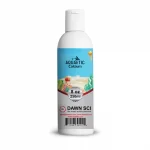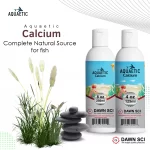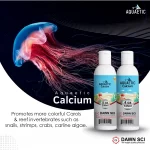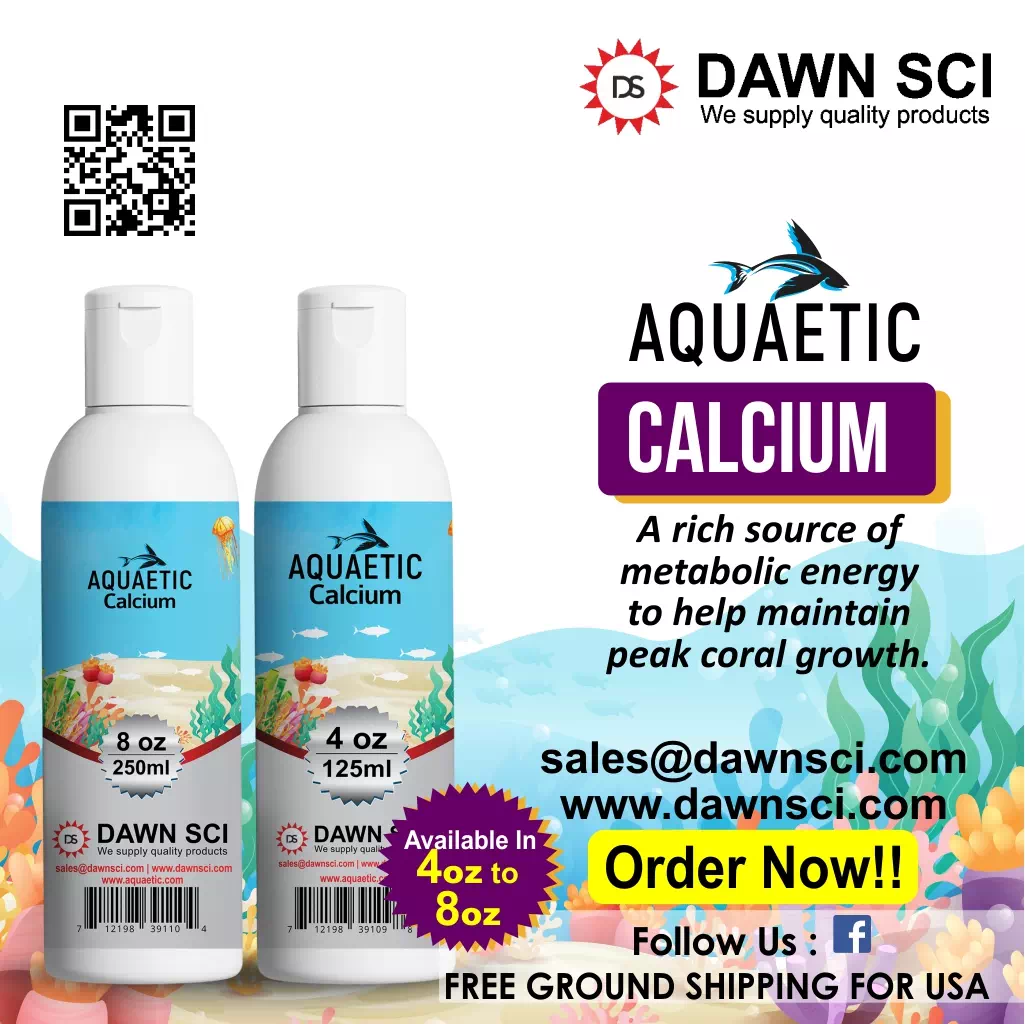In natural reefs, Calcium Level is very essential, and it is gradually dropping in reef Aquarium as invertebrates utilize the Calcium from water. The Calcium concentration should be 400-500 ppm (mg/L). Aquaetic Calcium is a natural way to increase Calcium levels in your reef Aquarium and should be used whenever Calcium deficiency is present in your water. Use Aquaetic Calcium when water tests show a Calcium level below 400ppm.
- Promotes more colorful Carols and reef invertebrates such as snails, shrimps, crabs, carline algae.
Directions: Add 5 ml. per 10 gallons of Aquarium water whenever you find Calcium level is down to recommended level.
Ingredient: Deionized Water, Calcium Chloride (Calcium Content 3.63-4.30 %)
1 oz can treat up to 60 gallons.
Made in the USA.
Disclaimer : Any of above statements have not been evaluated by the food and drug administration (FDA).This product is not intended to diagnose, treat, cure, or prevent disease. This information provided is general and should not be taken as medical advice. This product is for research use only.We strongly advise you to have a test batch before use. If you suffer any adverse reactions or symptoms, please discontinue use immediately.
Why do we test for calcium in water?
The use of accurate calcium ion testing in controlling the quality and calcium content of water products ensures that consumers are accurately able to gauge their calcium intake. It also enables one to determine whether or not scaling will occur with boiling of their water.
Is calcium safe for aquariums?
Some calcium supplements will raise the alkalinity and boost the pH to saltwater levels. However, this is probably not ideal if you want to maintain a freshwater tank with a pH range in the 6.5 to 7.5 range. If the product is a single liquid containing calcium chloride, it is OK to use in your freshwater aquarium
Effects of Too Much Calcium
Many freshwater species can survive outside their ideal range, and even thrive. Sudden changes to water chemistry damage fish more than keeping fish outside of their ideal range. However, extreme values and sudden changes can stress and kill aquarium fish. In the saltwater side of the hobby, fish and invertebrates are more particular; they stress more easily outside of their ideal conditions. Overshooting the calcium changes all of the other values, and stresses fish and invertebrates. Stress manifests differently in different organisms, ranging from lethargy to erratic swimming or growing more slowly than usual. In extreme cases, too much calcium can kill aquarium organisms.
Why do Aquariums need calcium?
Natural water sources like lakes and rivers have calcium deposits because of the erosion of stones. Nearby plants, invertebrates, and fish absorb the calcium and use the nutrient for growth and development.
The concentration of calcium in natural freshwater sources is anywhere between 0.5 milligrams per liter and 75 milligrams per liter, depending on the landscape. The American Midwest sees calcium concentrations of about 20 milligrams per liter (0.003 oz per gallon) in most lakes. Meanwhile, marl lakes in areas with high limestone content have much higher calcium levels.
The lowest freshwater calcium concentrations are found in the boreal zones of Canada and Europe, where the levels are about 5 milligrams per liter (0.0007 oz per gallon). Lakes at and below this calcium level aren’t suitable for many invertebrate life forms, who rely on calcium absorption for building their exoskeletons.
How often do you add calcium to aquarium?
Your freshwater aquarium should have a calcium hardness of about 70 to 90 mg/L (0.009 to 0.012 oz/gal), which you can check with a calcium testing kit like the Aqua Care Pro testing strip set. This allows you to quickly and accurately determine whether it’s time to change or add more calcium additives.
You can tell that you have too much calcium in your fish tank if scaling starts to appear on the edge of the water, but there isn’t a quick visual way to see that you have too little calcium in the tank; you really need to find a calcium testing kit.
Usually, you’ll need to add more calcium every couple of days. However, this varies according to the calcium demand of the species you have in your tank, so you should always test the calcium levels in your aquarium before you add more.
Different sources of calcium have different concentrations. This means that where you might need to add just a small amount of kalkwater, you’d need a large piece of cuttlebone to reach the same level of calcium.
Remember that you can combine different methods of adding calcium to the water depending on your needs. You can use one primary source of calcium, like slow-releasing ground coral, and then add a liquid additive like calcium chloride as needed to balance the mineral levels. Just be careful not to add too much because this can cause severe problems and even death.
What happens if you add too much calcium to aquarium?
Although you can get away with including a large piece of calcium-rich substance in your aquarium, you need to make sure that it’s dissolving at an appropriate rate so that it doesn’t overwhelm the tank with too much.
One sign that you have too much calcium in your tank is that it starts scaling or solidifying on the edges of the tank. This can cause major problems for your fish and can clog your water filters.
Most fish and other aquatic species can survive outside their ideal range of calcium concentrations but have difficulty handling sudden water chemistry changes. These sudden changes can cause stress, lethargy, erratic swimming, growth problems, and even death.
You should be especially careful about adding new fish to your aquarium and making sure that your tank’s water chemistry matches the environment the new fish is coming from.
What About pH?
The term pH refers to the number of hydrogen and hydroxide ions in the water. Normal water has an equal balance of both, resulting in a pH value of 7.0 on a scale of 14.0. Acidic solutions have a lower pH than normal water, and alkaline or basic solutions have a pH higher than 7.0.
Different fish are accustomed to different pH levels according to the water sources where they come from. Saltwater fish tend to thrive in water with a higher, more basic pH, where freshwater fish tend to prefer a lower, more acidic pH. The right pH for a freshwater tank is usually between 5.5 and 7.5, but you should be sure to check the right pH for your species.

The following are recommendations for water pH for different freshwater fish species:
Angelfish: 6.5 – 7.0
Clown Loach: 6.0 – 6.5
Goldfish: 7.0 – 7.5
Harlequin Rasbora: 6.0 – 6.5
Hatchetfish: 6.0 – 7.0
Neon Tetra: 5.8 – 6.2
Plecostomus: 5.0 – 7.0
Silver Dollar: 6.0 – 7.0
Tiger Barb: 6.0 – 6.5
Zebra: 6.5 – 7.0
Like with calcium levels, the most important thing for your fish is to avoid sudden water pH changes. You should know what the pH of the fish’s source water is and make sure that the different fish you’re keeping have compatible needs. Taking your fish home from a pet store aquarium with a different pH than your home aquarium is a leading cause of early fish death.
How Calcium Levels and pH are Related?
When an aquarium has a low pH, this means that the water is more acidic and will more readily dissolve calcium-rich mineral substances like cuttlebones and oyster shells. This means that a low pH will increase the amount of calcium in the water, provided that there’s a source of calcium there to be dissolved.
When calcium dissolves into the water, it acts as a buffer, preventing the pH from drastically changing, even with the addition of a strong acid or base. This means that as the pH begins to drop, the calcium will dissolve and cause the pH to stabilize.
However, if the pH is too high, the calcium will not dissolve, and therefore will not act as a buffer preventing the water from becoming too basic. This results in water that is too low in calcium and too high in ammonium ions, leading to the development of ammonia, which is toxic to fish and can result in death.
That’s why it’s important to measure both the pH of your water and the calcium levels: because they’re related and can have serious consequences if not handled properly.














































Reviews
There are no reviews yet.